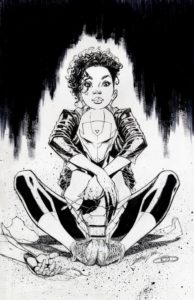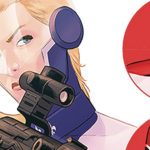

We’ve seen this happen before where a cover winds up getting pulled after fan outrage makes the publisher second guess their choices and we need to hold Marvel and DC accountable to these choices. An artist doesn’t just send in ANY cover and expect the publisher to just go ahead and make it happen. That’s NOT how this works. How it TYPICALLY works is the artist sends in a few different thumbnails and the editor looks over them and selects the one that they feel best represents what they’re trying to go for. So while Campbell is to blame for drawing the cover in the first place, the editors and the publisher are the ones truly at fault for letting it go to print in the first place and not seeing what was so ridiculously wrong with how Riri was portrayed.
The biggest upset over this recently (aside from this specific instance) was when Frank Cho was taken off the Wonder Woman variants after writer, Greg Rucka, said that Cho’s version of the character wasn’t in line with what they were trying to portray. PERFECT. It SHOULD be like this where creators stand up to other creators and call them out when what they’re trying to convey isn’t coming across. Comics are a medium that require words and images to BOTH tell the story and the same goes for the cover too. A picture is worth a thousand words and all that.
Instead of Frank Cho taking this news and wondering to himself what he could do to make the character more in line with Rucka’s vision, Cho threw a huge snit. This is probably not a shock to anyone who has seen Cho’s art criticized in the past and his subsequent reactions.
Cho is part of a BIG man baby problem in comics. He’s extremely talented and he knows it. But his talent isn’t the thing in question when it comes to Frank Cho, it’s his hyper-sexualization of characters. There is ABSOLUTELY a time and a place for this. I typically enjoy Cho’s art and I really enjoy his pin-ups. I LOVE pin-ups generally speaking and I think they’re a great way to create a sexy look. I do NOT love Cho’s behaviour. When he receives any sort of criticism, he flies off the handle and responds by posting an even more salicious version of the cover along with headlines meant to antagonize and feed the fire. He gets the mobs of fans who are stuck in the past together to rally to his side. He encourages them to behave badly and not change with the times by not realizing his mistakes. At the comic convention in Lucca recently, Manara (who infamously drew the most ridiculously posed Spider-Woman cover and received a TON of well-deserved grief) presented Cho with a picture that was basically a show of their manly stand against the haters of the world. It was a very NSFW drawing of Spider-Woman (read about it and more of ALL this at HitFix in this related article by Jill Pantozzi).
Cho, Manara… WE ARE NOT DOUBTING YOUR TALENT. This is not in question. We are asking you to think of how women WANT to be portrayed. Let’s say HYPOTHETICALLY your daughter was Riri Williams, a 15-year old GENIUS (I know she’s a fictional character but use your imagination here). Would you want some older man that was old enough to be her GRANDFATHER lusting after her and creating a fanbase of dudes that will be jerking off to her? NO. NO YOU WOULDN’T.
Women are sexual too and again, it’s fine to have pin-ups and sexy covers but try to keep in mind that women would also like to be respected and taken seriously too.
Going back to the whole thing with the publishers again, they should know better than to hire artists like Cho and Manara to do covers for books that require some tact. Especially when they’re in the middle of trying to create a better image for the character that ISN’T all about how the characters looks.
I’ve gotten very sidetracked from my initial point here, but I swear it all had relevance here. I very much condemn Cho’s behaviour on a personal level and there is no place on my pull list for any of his work knowing his current attitude.
Which brings me back to J. Scott Campbell. When I first saw Campbell’s image, titled Riri Redux, I was initially skeptically. I was disappointed that he came up with this image just for the heck of it but dropped the ball when it really mattered for the cover. Campbell made a statement that coincided with the image:
“Sometimes these covers, like this one, are drawn in haste to meet a deadline and you have fly by the seat of your pants and fall back a bit on instinct rather than ultra-careful thought. Perhaps with more time, I could’ve contemplated another more nuanced approach. I have young daughters and I would not be embarrassed for them to see this cover.”
I changed my opinion on the piece and instead of feeling disappointed, I felt hope. Campbell, like Cho, is known for his pin-ups and sexy lady art, but as mentioned, it wasn’t really welcome here for a character that’s meant to be 15 years old. However, I really appreciated that he took responsibility for his piece and apologized for how he chose to depict Riri. He could’ve left it simply at an apology but he went forward and decided to draw the character in a better light and show us that he wanted to do better by his fans. What’s more is that he acknowledged his daughters and that he wouldn’t want them to see Riri in this light.
It’s SO important that creators continue to grow and change with the times. I can’t say enough good things about this piece of art. THIS piece is one that I hope Marvel decides to use as a cover. THIS piece is one that I hope Marvel sees and thinks “Oh, so this is how we should have young women drawn!”
Amy Reeder knocks Moon Girl and Devil Dinosaur covers out of the park every single time she’s up to bat and I really hope that it doesn’t just take a female artist to respectfully draw the female figure.
Women come in many different shapes, sizes, colours, and ages. There are many ways to draw women and not all of those ways should be solely for the male gaze.
If you want to read my full threads on Twitter (which more or less say all of this in 140 character bursts), visit here and also here.



